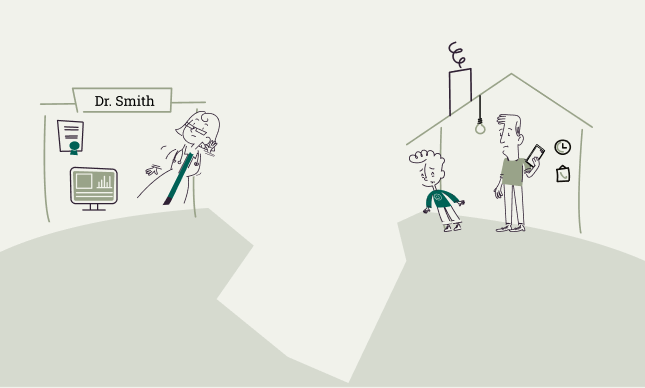Closing the Home Health Delivery Gap™

Where does home-based healthcare fall short, and what can be done about it?
Primary care today
Today’s primary care falls short in several key areas. Primary care has become overly costly, inefficient, and less accessible than it should be. The shortcomings of primary care can leave people with no other choice but to go to the ED to have their healthcare needs met.
Physician shortages have risen and are expected to grow over the coming decade. Long wait times and limited appointment availability have meant that patients must wait nearly a week on average to see a primary care provider.
Long travel distances in healthcare deserts across the US also make it difficult for rural residents and many others to access appropriate and timely care. Social determinants of health pose an additional challenge to overcoming health barriers and equitably meeting the care needs of all people.
Traditional telehealth falls short
Audio and video telehealth was meant to help ease the challenges of primary care. But aside from a sharp rise in use during the COVID-19 pandemic, it has remained underused and unable to deliver on its promise.
Telehealth has been a disappointment to health plans, with user engagement rates falling short of projections. Low rates of telehealth utilization and adoption have negatively impacted health plans’ ROI and bottom lines.
Members have also been let down by audio/video telehealth approaches. Many traditional telehealth visits require additional in-person follow-up care. Underserved populations continue to be left behind, thanks to an inability to access traditional telehealth. Telehealth fails to offer culturally and socio-economically competent care, causing existing care gaps to worsen.
For telehealth to address primary care’s shortcomings, it must enable accurate remote diagnoses while building trust with clinicians. Successful telehealth requires a forward-thinking approach that does not compromise on the quality of care.
The Home Health Delivery Gap™
Our homes, which are the epicenter of our daily lives, are unable to deliver quality healthcare that is on par with an in-clinic visit. Traditional, audio-visual only telehealth has kept the home disconnected from our healthcare experience.
Among the ramifications of the Home Health Delivery Gap™:
Members lack access to primary care, which worsens care gaps, exacerbates chronic issues, and leads them to rely on costlier, inefficient solutions like the ED.
Clinicians and other healthcare providers continue to face strain and burnout. They lack effective and efficient means to monitor patients and track their care over time.
Health plans experience higher total cost of care due to ED overutilization and unnecessary spend on laboratory tests and prescriptions. They face poorer health outcomes for members, poor quality of care, and lower member satisfaction rates, which leads to disenrollment and lower acquisition.
Value-based health systems face higher total cost of care, lower revenues, lower acquisition, and poorer rates of retention. Their pressing issues, such as staff shortages, fail to be alleviated.
Fee-for-service health systems must contend with lower revenues, lower acquisition, and lower retention, as primary care continues to be neglected and underfunded.
Closing the gap
Home-based healthcare – when it’s done right – is a convenient, affordable, and innovative alternative to in-clinic visits. Today’s home-based healthcare solutions deliver greater value while maintaining excellent care quality, and experts expect this shift to continue. However, the type of care that’s offered matters, as some telehealth models risk further exacerbating gaps, rather than alleviating them.
Healthcare from home has the potential to improve health equity and keep members out of the ED and avoid readmissions. People are ready and willing to welcome telehealth into their lives. 86% of adults shared that they preferred to receive short-term post-hospital care at home.
Stakeholders across the healthcare spectrum agree that the current challenges of home-based healthcare must be resolved. Health plans increasingly view primary care from home as an integral component of their offering. While they are aware that telehealth is not optimized for success in its current form, they understand the significant role home-based care will play going forward.
There is no reason why a remote physical exam should be any less effective than an in-clinic visit. In fact, the right home-based care solution can improve upon the in-office experience by offering greater convenience, lowering costs, coordinating care, increasing equity and accessibility, and more.
TytoCare’s Home Smart Clinic resolves these challenges, allowing home-based healthcare to fulfill its immense potential. Addressing the Home Health Delivery Gap™ paves the way forward for telehealth’s success, benefiting everyone.
Learn more about the Home Smart Clinic here.





